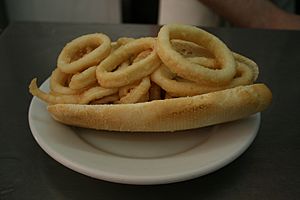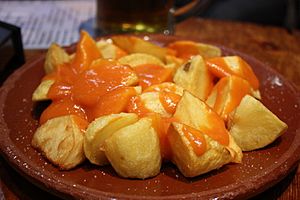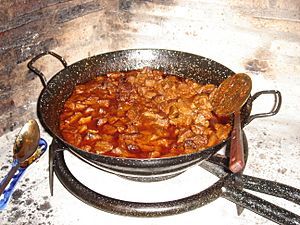Cuisine of the Community of Madrid facts for kids
The cuisine of the Community of Madrid is a mix of food traditions from many parts of Spain. This happened because lots of people moved to Madrid when King Felipe II made it the capital city. As the city grew, it also took in the cooking styles of the towns around it.
You can often smell food cooking in Madrid. Things like churros, tortilla de patatas, bocadillos de calamares, and patatas bravas are often fried. You can smell these tasty dishes being made at any time of day.
History of Madrid's Food
The story of Madrid's food began in the late 1500s. That's when King Felipe II made Madrid the capital. People from all over the Spanish Empire came to the city. They brought their own unique customs and food traditions with them.
Some of Madrid's oldest and most famous inns opened during these early years. The Posada de la Villa opened in 1624. Casa Botín started serving food in 1725.
One of the first restaurants was Lhardy, which opened in 1839. This led to many other similar places opening up. In 1873, a businessman named Matias Lacasa came from Vienna. He opened a bakery to sell his special pan de viena. His bakery grew into the famous Viena Capellanes chain of pastry shops.
Today, Madrid has many restaurants. You can find both traditional Spanish dishes and food from all over the world. Visitors love Madrid's food. Their only surprise is often the meal times. In Spain, dinner is usually served between two and four in the afternoon. A lighter supper is eaten after ten at night.
Typical Dishes to Try


Eating tapas is very popular in Madrid. This means visiting several bars. You order small, different dishes to share with your friends or family. Many of these small dishes can also be ordered as full meals in restaurants.
Here are some typical local dishes:
- Cocido madrileño: This is a popular beef and vegetable stew. It's often a special on Tuesdays. It has chickpeas, meat (usually beef), vegetables, and sausage. The dish is served in three parts. First, you get a broth-based soup. Next, you eat the beans and vegetables. Finally, you have the meat and sausage.
- Callos a la madrileña: This dish is made with tripe (cow's stomach). It also has chorizo, blood sausage, cow's hoof and snout, and sweet paprika.
- Oreja a la plancha: This means "grilled ear." It's a common pork dish. Some people need to try it a few times to like it. It can be made with garlic, spicy sauce, or in the Basque style.
- Gallinejas: This popular dish is made of fried sheep insides.
- Gambas al ajillo and setas al ajillo: These mean "prawns with garlic" and "mushrooms with garlic." They are served very hot. They are popular appetizers for the midday meal.
- Bocadillo de calamares: This is a sandwich with fried squid rings. You can find it in almost every bar.
- Patatas bravas: This is a very common dish. It has fried potatoes cut into irregular shapes. They are covered in a spicy tomato sauce.
- Soldaditos de Pavía: These are strips of unsalted bacalao (cod fish). They are battered and fried.
- Caracoles a la madrileña: This is a tapa made of snails cooked in a spicy sauce.
- Carne al desarreglo: This is a beef stew.
- Huevos estrellados: This dish has eggs fried in olive oil. It's served with fried potatoes (like French fries or potato chips). Often, it also has sliced meat like ham or bacon, or sausage like chorizo.
Sweet Desserts
Madrid is famous for its many traditional pastries. Here are some common ones:
- Buñuelos rellenos: These are a type of stuffed fritter.
- Rosquillas tontas y listas: These are like donuts. They can have a sugary glaze, dry meringue, or almond dust. You can usually find these pastries in May, especially around the Feast of St. Isidore the Laborer.
- Roscón de Reyes
- Torrijas: This is a type of fried bread. It's often eaten during Holy Week.
- Tejas and barquillos: Street sellers often sell these pastries throughout the city.
Drinks of Madrid
Madrid has its own special protected area for wine. This area is divided into three zones: Arganda, Navalcarnero, and San Martín de Valdeiglesias. Together, they have about 22,000 hectares of vineyards.
A popular anisette liquor called Anís is made from anise grown in Chinchón. It's a typical drink to have before a meal.
Two popular non-alcoholic drinks are:
- A cold cinnamon- and lemon-flavored meringue drink.
- Horchata de chufa: This is a sweet drink made from chufas (tiger nuts). It originally comes from the Valencian Community.
See also
 In Spanish: Gastronomía de Madrid para niños
In Spanish: Gastronomía de Madrid para niños


